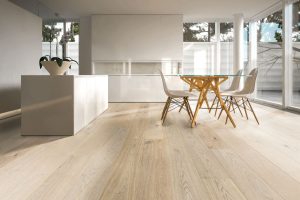If you’re choosing between solid oak and engineered flooring, the best option really depends on where you plan to install it and how much wear it’s likely to experience. Both types are made with real wood, but their construction, durability, and installation methods are very different. Solid oak is known for its authenticity and longevity, while engineered flooring offers greater flexibility and stability, especially in areas with moisture or temperature changes. Understanding the pros and cons of each can help you pick the right one for your home or project.

Structure and Material Differences
Solid oak flooring is made from a single piece of hardwood from top to bottom. It’s thick, usually about 3/4 inch, which means it can be sanded and refinished multiple times over the years. Engineered flooring, on the other hand, is built from several layers. The top layer is a thin slice of real oak, while the bottom layers are made of plywood or high-density fiberboard. This layered structure makes engineered flooring more resistant to expansion and contraction caused by changes in humidity and temperature.
Durability and Longevity
Solid oak floors are extremely durable and can last for decades, even generations, if maintained well. Because they’re thicker, they allow for repeated refinishing, which is useful if the floor gets scratched or worn down. Engineered floors are also durable but generally can only be refinished once or twice, depending on the thickness of the top oak layer. However, engineered flooring handles moisture better, making it ideal for basements, kitchens, and bathrooms where solid wood might warp.
Appearance and Style
Both solid oak and engineered oak look similar on the surface since they use the same wood species. The top layer of engineered flooring is actual oak, so you’re still getting that authentic wood grain. What you might notice is a difference in plank width and length options—engineered flooring often comes in wider and longer boards because it’s more stable. This can give rooms a more modern or open feel. Solid oak tends to be available in more traditional sizes.
Installation Methods
Solid oak flooring is typically nailed or stapled down, which limits it to being installed over wood subfloors. It also needs to acclimate to the room’s climate before installation. Engineered flooring is more versatile. It can be glued down, stapled, or floated over most subfloor types, including concrete. This makes engineered flooring a better choice for below-grade rooms or projects that require quicker installation.
Cost and Budget Considerations
Engineered oak flooring is usually more budget-friendly upfront, especially when you factor in installation. It tends to be cheaper per square foot, and the installation costs are often lower because it’s easier and faster to put in place. Solid oak is more expensive both in material and labor, but its long-term value and lifespan might make it worth the higher initial price if you’re planning to stay in your home for many years.
Which One Is Better?
If you want a floor that can last for generations and you don’t mind spending a little more, solid oak is a great choice. But if you’re looking for something that’s easier to install, performs well in a variety of environments, and still offers the beauty of real wood, engineered flooring might be the better option. In the end, both offer the warmth and charm of oak—you just need to choose the version that fits your lifestyle, budget, and space.




